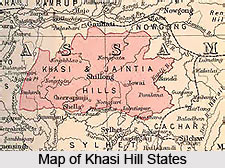 Khasi Hill States included a number of former Princely States of India that was situated in the hilly regions during the reign of the British Empire in India. During the rule of the British Government of India, 2 separate groups of princely states in the Indian regions of the British province of Punjab were included into British dominated India later than almost all of the Mughal Empire, in the context of 2 wars and a revolt. The Khasi Hills, located on the east of the Garo Hills and the Jaintia Hills were primarily incorporated as a part of Tribal Assam under colonial British India. It is currently situated in the modern Indian constitutive state of Meghalaya. The other Khasi tribes did not have princes but their 20 petty states, and sometimes even smaller tribal divisions, are led by 1 or 2 Chiefs -selected in various ways- usually styled Siem, Syiem.
Khasi Hill States included a number of former Princely States of India that was situated in the hilly regions during the reign of the British Empire in India. During the rule of the British Government of India, 2 separate groups of princely states in the Indian regions of the British province of Punjab were included into British dominated India later than almost all of the Mughal Empire, in the context of 2 wars and a revolt. The Khasi Hills, located on the east of the Garo Hills and the Jaintia Hills were primarily incorporated as a part of Tribal Assam under colonial British India. It is currently situated in the modern Indian constitutive state of Meghalaya. The other Khasi tribes did not have princes but their 20 petty states, and sometimes even smaller tribal divisions, are led by 1 or 2 Chiefs -selected in various ways- usually styled Siem, Syiem.
The Khasi and Jaintia Hills are a mountainous region that was mainly part of Assam Province in British India. This area is now part of the present Indian constitutive state of Meghalaya, formerly Assam,
including Jaintia district, capital Jowai, East Khasi district, capital Shillong, and West Khasi district, capital Nongstoin.
The Jaintia Hills are located further to the east from the Khasi Hills. The Jaintia Hills consisted of around 12 native rulers of the tribal province. The native chiefs belonged to the Pantars (Syntengs) tribes, which was a Khasi sub tribe. The rulers belonged to the regions of Sutnga, Shangpung, Raliang, Nongtallang, Nongphyllut, Nongjngi, Nongbah, Mynso, Lakadong, Jowai, Amwi and Nartiang. The Raja of Jaintiapur was the only princely ruler of the region, who presided over the petty chiefs. His winter capital is now in Bangladesh, with his summer residence shifted from Sutnga (where the family started as Syiems) to Nartiang; also a palace in the commercial center Borghat.
The different states in the Khasi kingdoms were not administered by native princes, but around 20 petty states and other smaller tribal divisions were managed and supervised by 1 or 2 chiefs. The rulers were chosen through various ways and held the title of Syiem (Siem). The chieftainships included Sardar or Sohiong, Shella, Rambrai, Pamsanggut, Nongstoin, Nongspung, Nongkhlaw, Noglwai, Nobosohphoh, Mylliem (including Shillong city), Mawphlang, Mawlong, Mawiang, Mawdon, Marriw, Malai Sohmat, Maharam, Lungiong, Langrin, Khyrim, Jirang, Dwara (capital Hat Dwara), Cherra or Sohra and Bhawal.
At present, the former Khasi Hill states are located in the Garo Khasi range in the north-eastern state of Meghalaya, India. It lies in the central part of Meghalaya and the Garo Khasi range is a part of the Patkai range of the Meghalaya subtropical forests eco-region. The region comprises of mainly hilly regions which also include the Shillong plateau. It is drained by the tributaries of the Surma and the Brahmaputra Rivers. The territory is mainly dominated by the Khasi tribal communities.



















